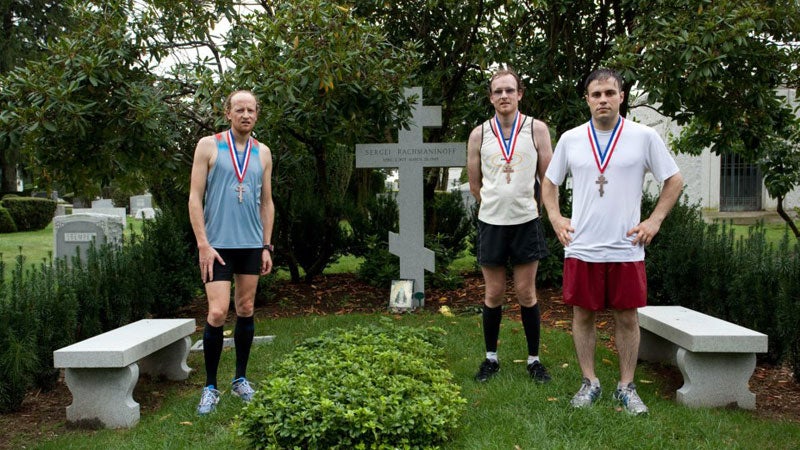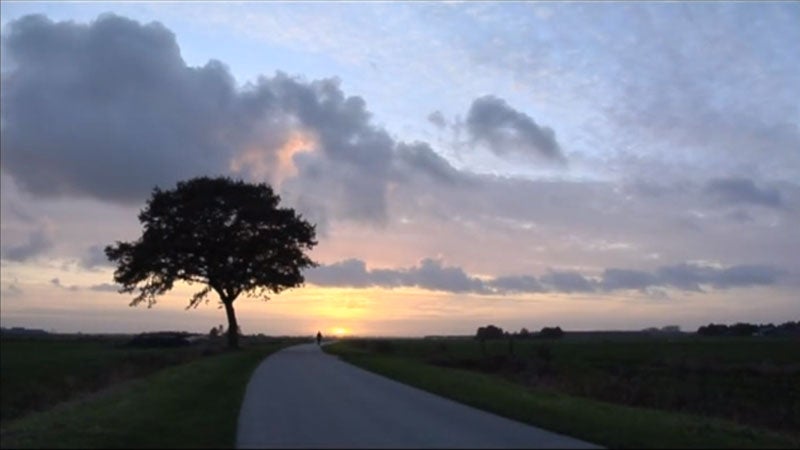On Sunday morning, December 1, Dutch filmmaker and performance artist , 36, set out on a long run. As part of the performance art festival Performa, Van der Werve was leading the Fourth Annual “Running for Rachmaninoff’,” which involved traveling on foot from his gallery, Luhring Augustine, in Chelsea, to the gravesite of the late-Romantic composer Sergei Rachmaninoff, located in Valhalla, New York, some 34 miles away. He invited anyone who was interested to join him, and, this year, 13 people showed up, all of them avid runners, and all of them admirers of Guido’s work.
Pale, lean, cheerful, and soft-spoken, Van der Werve has all the idiosyncratic streaks one might expect from a contemporary artist who is also an accomplished endurance athlete. Since 2002, when he entered the (more or less on a whim), he has completed multiple marathons and triathlons, and for the past six years, he has sought to incorporate acts of physical endurance into nearly all of his works.
In 2008, Van der Werve started his “Number” series—short films that incorporated endurance sports as a central motif. In “Number thirteen, home,” (2012), the latest in the series, he staged a 1,200-mile triathlon that began when he filled a chalice of soil in Poland, near the birthplace of his favorite composer, Frédéric Chopin, and ended a few weeks later, when he arrived at the Père Lachaise cemetery, in Paris’s 20th arrondissement, and emptied it at Chopin’s gravesite.
[quote]If you think about how composers work, they use very, very personal feelings, and they basically abstract them in a more universal language. That’s also what I’m trying to do.[/quote]
When Chopin was buried, in 1849, his sister Ludwika had his heart removed from the proceedings, and at the composer’s request, it was placed in an urn and spirited back to Warsaw. Carrying the soil with him as he ran, swam, and biked the path from Poland to France was an attempt to retrace the line that connected the place of Chopin’s birth to the place of his death. By making this work of performance art, Van der Werve explained, he hoped to translate his feelings about Chopin into something everyone could understand.
“If you think about how composers work, they use very, very personal feelings, and they basically abstract them in a more universal language,” he later said. “That’s also what I’m trying to do.”
Van der Werve overcame a nasty stomach bug from swimming in the Vistula River in Warsaw, and the transcontinental journey ended with him running seven marathons in seven days. But the triathlon itself was not the only part of “Number thirteen, home” that was radical or extreme. Having been trained as a classical pianist, Guido recruited sizable orchestras to appear on camera and perform compositions he had written himself. For several scenes, his crew traveled to Egypt and India to shoot on location. For one sequence, Van der Werve deliberately set himself on fire.
For other films in his “Number” series, he ran around his house in Finland for 12 hours, and climbed to the summit of Mount Aconcagua in Argentina. In 2007, he took a small crew to the Gulf of Bothnia, in the northernmost arm of the Baltic Sea, to film himself walking in front of an arctic icebreaker, 50 feet in front of the moving ship. That same year, Van der Werve traveled to the geographical North Pole, and stayed there for 24 hours, for a work titled “Number Nine: the day I didn’t turn with the world.”

Compared to these other projects, the tone of “Running to Rachmaninoff” is light—a few friends going out for a jog. Starting at 11 o’clock, the group ran through picturesque parts of Manhattan and the Bronx, and a bland chain of strip malls in Westchester County, before turning up the hill through the country roads that led to the cemetery. Grumbling about the cold and harsh wind, though cheerful and cordial all the way, they arrived at the cemetery gates just as the sun was going down. Per Van der Werve’s instructions, each participant placed a bouquet of chamomile flowers, which they had been carrying the whole way, at the base of the marble Orthodox cross that marked Rachmaninoff’s grave. “This flower is one of the most important central European remedies,” the artist explained, adding that chamomile was often used to treat mental illness in the era in which Rachmaninoff suffered from depression.
Ten of the 13 people who attempted the run that day completed it, and everyone, despite the fatigue, was friendly and garrulous. “Guido’s work is really up my wheelhouse,” explained Jesse Penridge, an art dealer, who connected the performative, physical activity involved in Van der Werve’s work to artists like Bas Jan Ader, Robert Smithson, and Matthew Barney. Avery Lawrence, an MFA student at CalArts in Los Angeles, travelled to New York specifically to take part in the run, having first encountered Guido’s icebreaker film at the Hirschhorn Museum, in Washington D.C., a year before. “All his projects, all of these physical acts—pushing his body, testing his limits,” he said. “A lot of beautiful things come out of that.”
A few of the runners took pictures. Others thanked a member of the cemetery security, who had helped them find the grave, and someone played Rachmaninoff’s “Piano Concerto No. 1” off of his phone before the group crowded into a van, and passed a bottle of bourbon to help shake off the cold. Once the van passed the gates, they began the much quicker trip back to New York.


